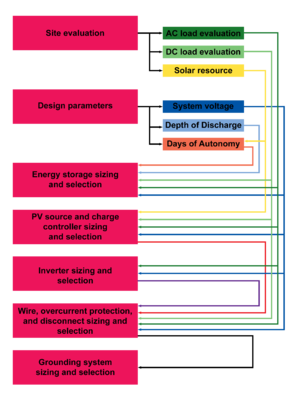Design process overview

There is no definitive systematic approach to design, thus the approach outlined by OSSP – which uses common practices and the National Electrical Code from the United States as a rough guide - is only one approach of many. The environment, the power needs, the available components, and the regulations will vary from location to location, which means that the process that is used to design an off-grid PV system will have to be adapted to each project. Additional factors that should be considered when performing a design will be explored in each step of the design process.
The approach to design is exceedingly important though as it is the first step in building a PV system that will perform properly and that will withstand the test of time. An improperly designed system, regardless of how well it is installed or the quality of the components that are used, will not perform as it should. The starting point for any design is an analysis of the loads that the system will be required to power and for how long, an analysis of the solar resource throughout the year, the parameters chosen for the efficiency of various system components, and the chosen design specifications for the system. Conservative values should be used for each of these variables. Playing with these numbers or using numbers that are not conservative can lead to a smaller and lower-cost design, but that will not meet end user needs and will not last as it should. Determining appropriate values for to use for calculations involving the solar resource or weather can be challenging for many locations as there may not be locally gathered data that can be relied upon. There are tools that use globally calculated data and perform calculations to estimate the solar resource and annual weather for locations throughout the world, but there is no one perfect tool. The general design principle underlying off-grid PV system is to design for the worst-case scenario in terms of poor solar resource and load usage. Yearly and monthly averages can sometimes hide periods of poor weather and limited solar resource; therefore, it can be useful to consult various resources that have daily or weekly data and consult people work or live in the region.
Beyond designing for worst-case scenarios, there are a few other universal design principles that should be followed regardless of the project:
- Understand the local context – electrical codes, legislation, local laws, required permits, enforcement – to avoid issues.
- It is likely that a person that wants an off-grid system has not likely used a system of this type and may not have even used electricity frequently beforehand. Therefore, it is the responsibility of the designer and installer to responsibly guide the person through all steps of the evaluation, design and installation process.
- Perform a methodical evaluation of the power needs, usage expectations and budget limitations that the system users may have. A good design is a compromise between these different factors.
- Use manuals and information directly from manufacturers for each component in the design process.
- Only quality components should be used as the savings from using low-quality components rapidly evaporates if there is a failure in a remote location. Quality is not synonymous with cost, there are many options in the market that are a good balance between the two factors.
On this website there are two different approaches to system design: a simplified and a detailed process. Both have the shared goal of making small-scale off-grid PV system design as accessible as possible, but have different intended uses.
Detailed design process
The goal of the detailed approach is to create an approach to design that is functional for as many different applications and geographic locations as possible. The only way to achieve this is by providing significant amounts of information to anyone using this process and requiring them to perform calculations and make design decisions. This result is that this approach is necessarily complex, time consuming, and demands a lot from a system designer.
Simplified design process
The simplified approach recognizes that the detailed design process may be too complex for certain individuals or applications. The goal of the simplified approach is therefore to try to create an approach that is as accessible to as wide of an audience as possible by providing a design tool. The only way to create a simplified design process is to make certain assumptions about the potential system and to impose certain design constraints. The inevitable result of making assumptions and simplifying a process is that there are some potential projects that will be excluded from the process and will require a more detailed design process, for example:
- Special applications that require additional considerations like medical facilities or agricultural applications.
- High seasonal variability in system usage or solar resource.
- The presence of a generator.